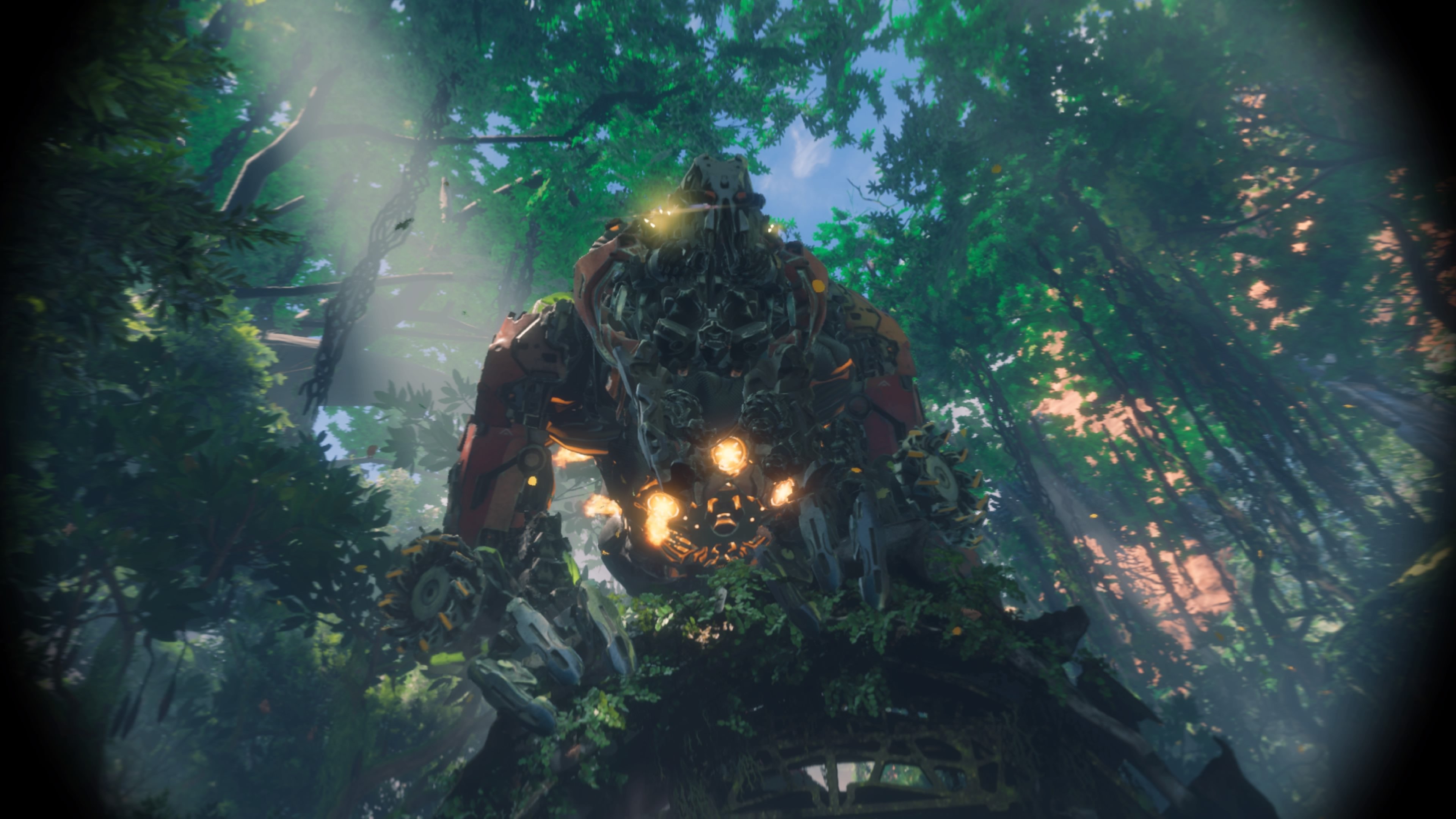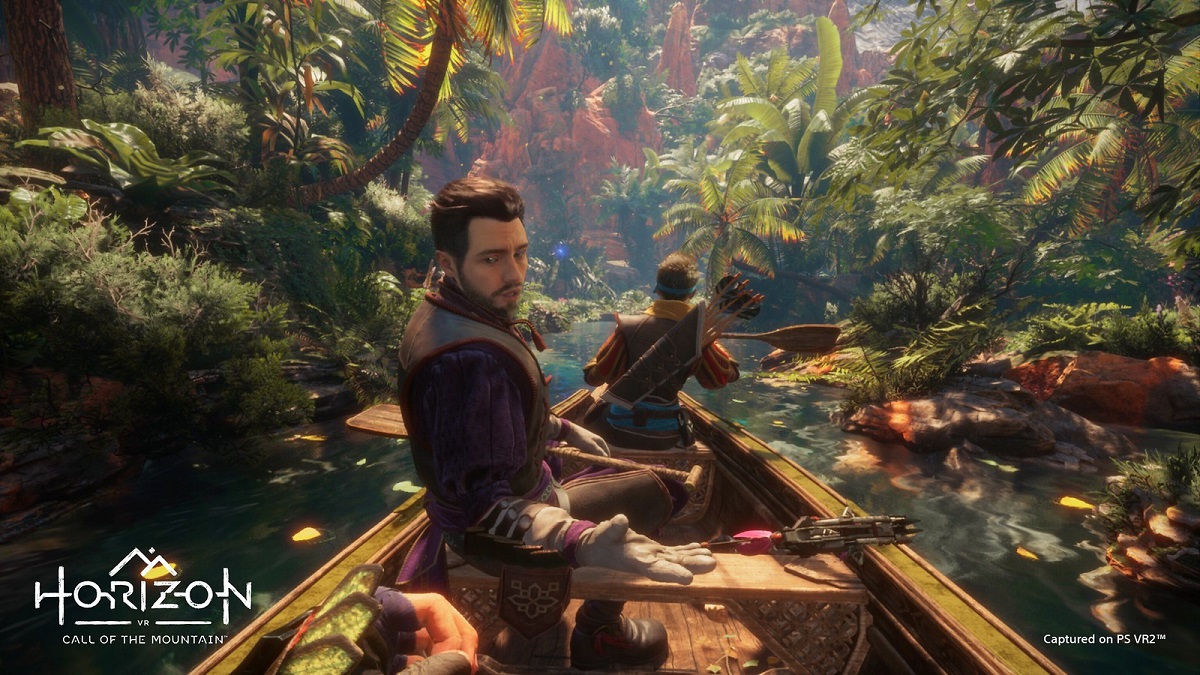I’ve long found VR games to be a sum of compromises. They usually look OK but not great, and they control well enough and have a threadbare story that’s at least an excuse to experience whatever scenario you’re playing out. But Horizon Call of the Mountain is different. It manages to succeed on so many levels and feels like the sort of fleshed-out title that new VR hardware like the PSVR 2 needs.
The post-post-apocalyptic world of Horizon is a fascinating amalgamation. Society has fallen, and nature has taken back control. The remaining humans war amongst themselves, and also a seemingly endless supply of machines styled after tyrannosauruses, massive crocodiles, pteranodons, and more.
The world is beautifully realized. A vibrant green canvas of trees gives way to harsh rigid peaks. Far-off vistas are detailed. The HDR OLED headset of PSVR 2 renders it all in impressive detail. Picking up objects to inspect up close is a great showcase for the device’s excellent motion tracking, and I enjoyed throwing plates like frisbees or trying to put a wicker basket on my head, even if the novelty wears off quickly.
Character models look really good, too, and the art style isn’t going for strictly photorealistic, which was the right choice by Guerilla Games and Firesprite. Having conversations with NPCs is lifelike, as everyone turns to face whoever is speaking, and characters look just animated enough to avoid the uncanny valley.
The fact that you don’t see protagonist Rhys while playing is helpful to avoid some of the cultural backlash Horizon draws, though it would be nice if he either had full gloves or customizable skin tones to really put you into the character.
Fighting and hunting take center stage in the mainline Horizon series, but Call of the Mountain takes a different approach. As Rhys, a Shadow Carja and expert climber captured by the Sun Kingdom, you find yourself scaling peaks to complete objectives, earning your freedom from your captors.
Free climbing mountains and other structures is the chief gameplay focus. The PSVR 2 Sense controllers act as your hands as you reach for various handholds, like ropes, cracks, and ridges. There is some movement on flat surfaces, with a few different options and settings to help avoid motion sickness, but the majority of time is spent with your feet dangling and your life in your fingertips.
It’s very intuitive. Being able to see your hands as your reach, shimmy, and climb, combined with excellent motion tracking, make it a reliable experience. Handholds are clearly marked with white paint or chalk. Leaning to peak around corners and find grips feels authentic, and as someone with longer-than-average arms, it was fun to see how far I could stretch and reach — or even leap when the time called for it.
The way Call of the Mountain utilizes haptic feedback is extremely impressive, as well. Small vibrations in the controllers convey a sense of texture. Grabbing and sliding down a rope has a distinctly different feel from digging your pickaxes into a rock surface. I was surprised when I dipped my hand in water at the start of the game and felt the flow of the water, and I was blown away when I instinctively reached up to brush away a vine, and it felt like I made contact.
There are other tools at your disposal while you climb, too, like a pair of climbing axes or ziplines. Some of the vistas offer amazing views as you clamber about, and the rush of wind, if you fall, is heart-stopping. It can be tiring in long stretches, which is a bit of an accessibility concern, but as a typically abled 30-something, I found the burn to be part of the immersion, so results may vary.
There is some combat in Call of the Mountain, primarily using a bow and arrow. This relies on readying and aiming with one controller while notching and drawing an arrow with the other. Like climbing, it feels natural and accurate. Anytime I missed a shot, it felt like the error was on my part.
Switching between the bow and other equipment is handled via a menu available on either hand. It makes sense conceptually, but looking down at your hands while avoiding a charging robot or hanging from the side of a cliff or mountain seems like it would be a terrible idea in real life. Solid eye tracking means making a selection is easy, though motion-based actions like jumping are a bit hit-and-miss at times.
A few quick dodge moves keep you out of harm’s way, though the fights are generally pretty simple — perhaps a bit too easy. The sheer spectacle of combat, though, like that against a Thunderjaw, makes them exciting.
Some crafting sections break up the action, and they’re mostly handled well; it took me longer to put my climbing axes together than I would have preferred. Pieces snap together fine, but winding string around a non-corporeal object was surprisingly tough to pantomime. It’s a decent implementation of a decent idea but feels more gimmick than immersive.
The total runtime for Horizon Call of the Mountain isn’t exceptionally long, and I finished somewhere around the 5-hour mark. It’s hard to say if that’s a good thing. VR fatigue is something to consider, and though I’d hoped to spend more time in Sony’s flagship VR title, the length seems suitable. There is some replayability in finding and shooting every target or nabbing every collectible, but it was hard to feel motivated without a compelling reward for finding things.
There are a few additional modes if you want to see more, as well. A safari option takes you on a canoe trip though the jungles, with several close encounters with mechanical beasts. A challenge mode lets you put your climbing and bow skills to the test. Neither is particularly deep, but both are worth experiencing at least once.
Horizon Call of the Mountain Review — The Bottom Line
Pros
- Gorgeous VR rendition of the Horizon world.
- Solid and intuitive climbing controls.
- Great use of haptic feedback.
- Giant robot dinosaurs, up close!
Cons
- Combat is limited and underdeveloped.
- Fatigue from the climbing motion could be difficult for some users.
- Crafting system can be a little frustrating.
Horizon Call of the Mountain is a really good VR experience. It looks great, controls well, and the free-climbing concept is well executed. It’s a nice adaptation of the Horizon world into VR. It’s a shame the experience isn’t a bit meatier; it would have done well with a more fleshed-out combat system in particular.
Still, the fact that I didn’t want to stop playing, even as my arms began to ache, is a sure sign that this is a fun experience. It’s maybe not a must-have system seller, but anyone who invests in a PSVR 2 would should give Horizon Call of the Mountain a playthrough.
[Note: The reviewer purchased the copy of Horizon Call of the Mountain used for this review. Featured image via GameSkinny.]











Published: Mar 14, 2023 03:43 am